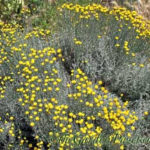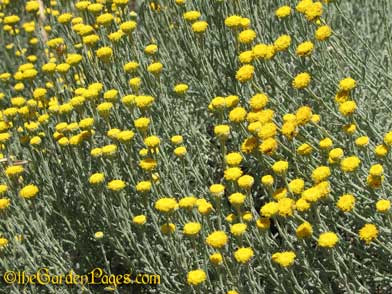Of all the flowering drought tolerant shrubs I have planted in my garden I count santolina, or Lavender cotton, as one of the best. This is a real tough customer when it comes to being completely drought tolerant in my hot, baking southern California garden. They tolerate full sun and summers that can reach over 100 degrees.
I freely admit to having a lasses-fair attitude towards watering. Factor in our mandatory water rationing in LA and I feel less a bit lazy. I planted my santolina in a dry bed with curry plant, sage and artemisia. The plan was to water them and get them established the first year. By the second year they were on their own. The plan worked out fairly well. When the Lavendar Cotton plant blooms, those bright yellow flowers make it the star of the show!
Being a Mediterranean native, santolina was a natural choice for my climate. I also have heavy clay alkaline soil, (yes, the kind they use to make the adobe bricks).
It started out as a small 4 inch pot. I like to start my plant experiments in 4 inchers because they’re cheaper and easier to find than 1 gallon containers and I feel less guilty if I wind up killing them off.
 These shrubs have tiny, slightly hairy grey leaves (sort of like lavender) on woody stems. They grow to about 1 foot tall and can spread over 2 feet wide. In summer they cover themselves with small lemon yellow button-shaped flowers. This plant is Santolina chamaecyparissus. There are a few named varieties including Nana and Lemon Queen. Their zones are; Sunset 2 – 24 or USDA 6 – 9, meaning they are hardy to about 35 degrees Fahrenheit.
These shrubs have tiny, slightly hairy grey leaves (sort of like lavender) on woody stems. They grow to about 1 foot tall and can spread over 2 feet wide. In summer they cover themselves with small lemon yellow button-shaped flowers. This plant is Santolina chamaecyparissus. There are a few named varieties including Nana and Lemon Queen. Their zones are; Sunset 2 – 24 or USDA 6 – 9, meaning they are hardy to about 35 degrees Fahrenheit.
Like real lavender, Lavender Cotton should be trimmed back in the fall. Otherwise they tend to form a woody thatch on the inside. If you don’t want to trim it all at once take it off in stages. After mine blooms I cut the entire branch back to about 8 inches. There will still a few branches with leaves on them to hide the bare twigs. After the short branch starts to leaf out, I’ll cut a few more long ones. Overall, the growth habit for this drought tolerant shrub is rounded and fairly neatly shaped. The whitish grey leaves make a nice contrast against greener shrubs.
This shrub would look pretty blooming with bright orange California poppies or deep blue Pacific Iris. It would have looked great with my sage, but they just missed each other by a few weeks. Let me know if you have tried this plant in your garden.
